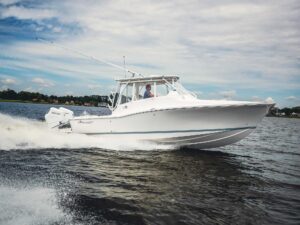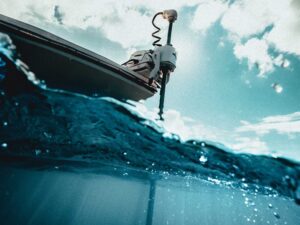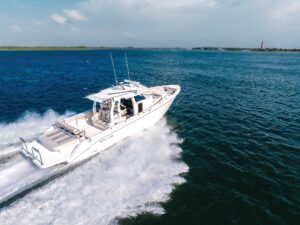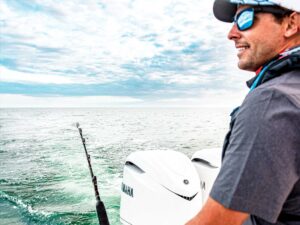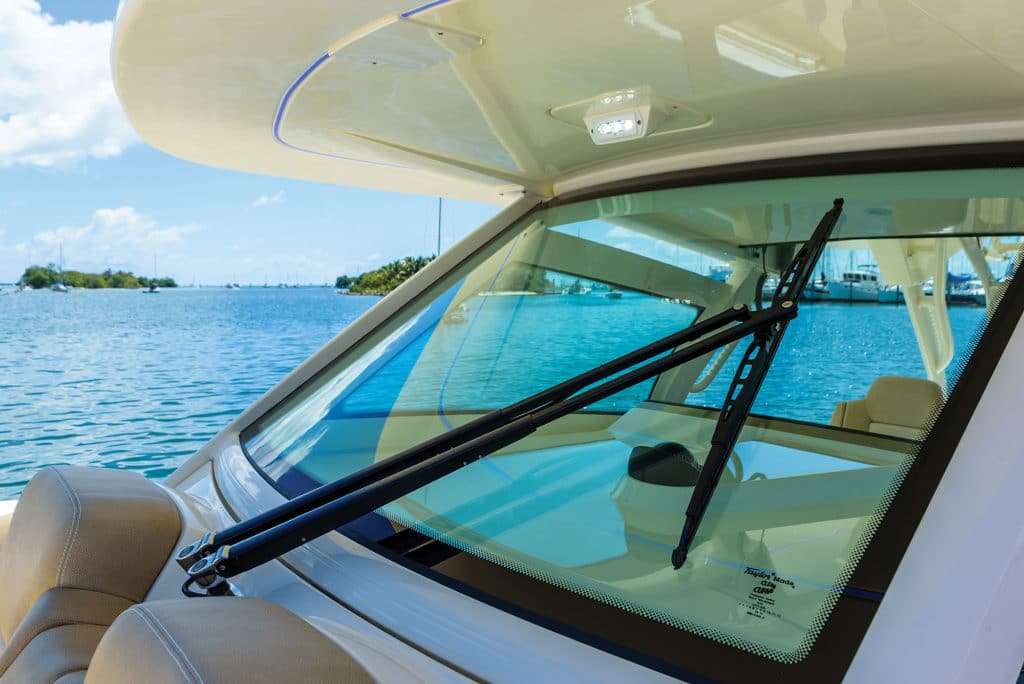
Advancements in glass molding and adhesive technology, coupled with the ingenious and dedicated work of marine designers, have sparked a revolution in boat windshields and windows.
Known as glazings in the marine-design field, the new wave of glass windshields and windows is not just strong and durable, but also affords more styling choices and superior visibility compared with other windshields made from materials such as clear acrylic, polycarbonate or vinyl.
“These new glass glazings first appeared in the marine market on superyachts,” says Rob Kaidy, chief designer for Miami-based Sea Vee Boats. Yachts require sweeping high-strength glazings, and today’s styling cues often demand complex curves, Kaidy points out. Suppliers such as Pennsylvania-based ProCurve Glass Design have tapped expertise in automotive and rail to build windshields and windows with curves that complement today’s yacht designs.
Bonding Experience
Around the same time, high-strength-yet-flexible bonding agents emerged from companies such as Michigan-based Sika. “Adhesives such as SikaFlex were born in commercial construction, where builders needed to secure large, frameless panes of glass to high-rise structures,” he explains. The adhesives also work well in marine applications, eliminating the need for frames, per se.
About 10 years ago, this technology began finding its way into saltwater fishing boats, albeit mostly on larger, high-end models. However, boat-industry experts agree that glass glazings are destined to trickle down to smaller fishing boats. As Kaidy puts it: “The advancements we’ve seen have changed the fundamentals of boatbuilding.”
To learn more about the glass-window revolution, I also talked with the designers from Grady-White and Scout Boats.
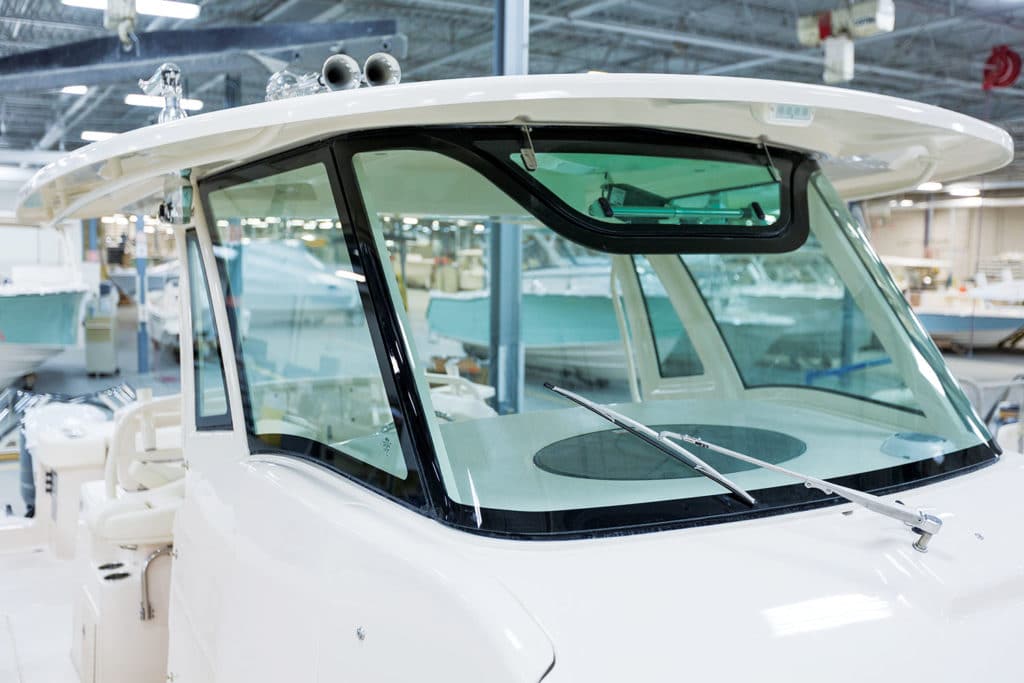
More Protection
One of the major benefits of the new wave in glazings lies in the ability to include a full-height glass windshield between the console and hardtop. A prime example of this shines through in Grady-White’s new Canyon 456, says Christian Carraway, new product engineer for the North Carolina-based boatbuilder. The windshield complements the integration of the console and hardtop.
“The glass also adds structural strength,” Carraway says. “At the same time, the adhesive allows for a certain amount of flex and expansion due to sea conditions and temperature differences between the glass and material to which it is bonded,” he says.
“People want more comfort than ever,” Carraway points out. Bringing the windshield all the way up to the hardtop and including full-height tempered-glass side windows protects the helm from wind blast, rain and spray, and also enhances the effects of onboard air conditioning and heating.
Better Optics
While a full-height windshield is possible with other materials such as clear vinyl or thin polycarbonate, optical clarity is better with glass. With laminated safety glass, there’s also greater protection from large waves or objects such as crab-pot buoys that might strike the windshield in heavy seas.
“Laminated safety glass is very strong and will not shatter into tiny pieces, and that makes it a better choice for forward-facing glazings than other materials such as acrylic or clear vinyl,” Kaidy contends.
Also, clear vinyl cannot be fitted with windshield wipers, as can glass. With spray, the inability to wipe the windshield can impair your forward vision.
Then there’s the convenience factor. With glass, there’s no need to put up the windshield and enclosure, and then take it down and find a place to stow it when you’re done for the day. Finally, glass offers far more durability and longevity than any other clear material, and it is highly resistant to scratching.
Scout Boats’ new flagship 530 LXF, expected to debut in early 2019, takes the protection factor up a notch, says Steve Potts, president of the South Carolina-based company. In addition to a full-height, wraparound glass windshield, the 530 LXF features motorized sliding side windows that extend aft, past the helm seating. “Just press a button for each side to create a hybrid pilothouse,” Potts explains.
“This does away with the need for side curtains or wings to protect the helm from side winds and spray,” he adds. “The sliding windows look great, and they make the air conditioning more effective.”
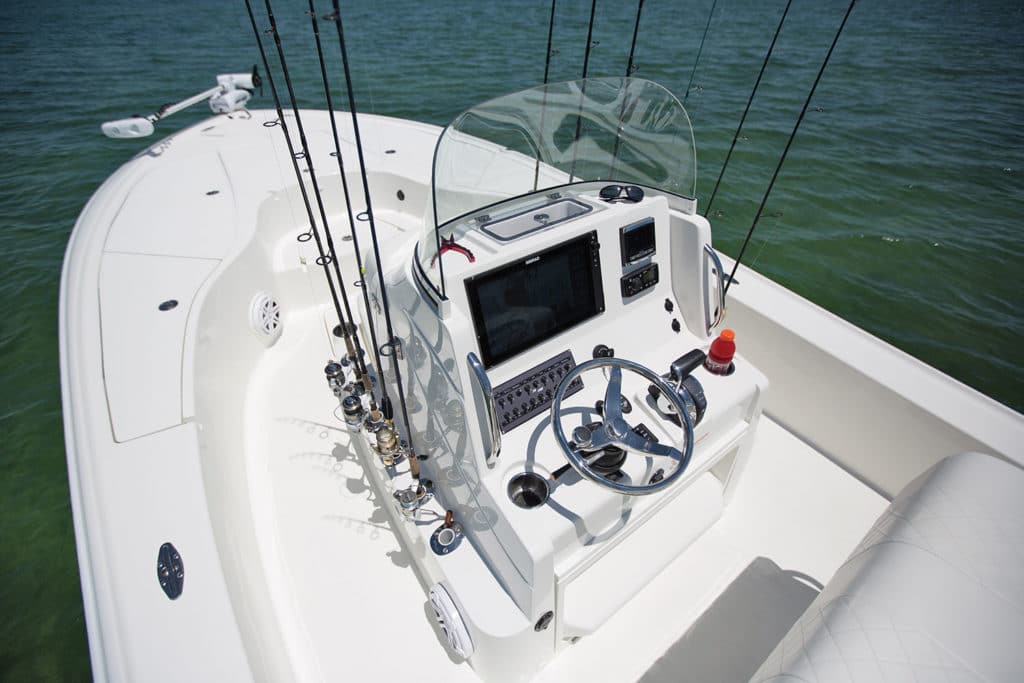
Fresh-Air Options
The permanence of glass glazings has a downside: You can’t remove the windshield and windows to get some fresh air. But boatbuilders have created ways to circulate air around the helm when you need it on sultry days.
On the Scout 530 LXF, for example, the motorized sliding windows can be quickly retracted to allow a refreshing breeze to sweep around the side and circulate in the helm seating area.
In another innovative touch from Everglades Boats, the patented hydraulic sliding glass windshields on the 295, 335, 355 and 435 center-console models retract downward to open the bridge area to a refreshing breeze.
The Grady-White 456 offers two ways to get more air. A motorized vent atop the windshield opens to let in a cooling breeze, and motorized sliding vents on the side windows let you circulate even more air in the helm area.
Read Next: Helm Enclosure Options
Smooth Styling
Curved-glass glazings give boatbuilders greater latitude in designing windshields and windows that flow with the graceful lines of the boat.
Carraway points to the windshield of the Grady-White 456 as an example. “This wide, one-piece windshield bends in two directions,” he says. “That’s a first for Grady-White.” The vertical- and horizontal-curving glass windshield complements the similarly curving design of the front of the 456 console.
Curving tinted-glass windows on the sides of the console serve not only to help illuminate the cabin inside the console, but also serve as accents for the overall design of the 456.
The ability to have sweeping one-piece windshields also eliminates the vertical frame members that disrupt an otherwise smooth design, not to mention possibly blocking the field of vision.
Ultimately, bonded-glass glazings have made boats safer, more comfortable and better looking, Kaidy says. “It’s truly a revolution, and I’m glad we’re finally talking about it.”


